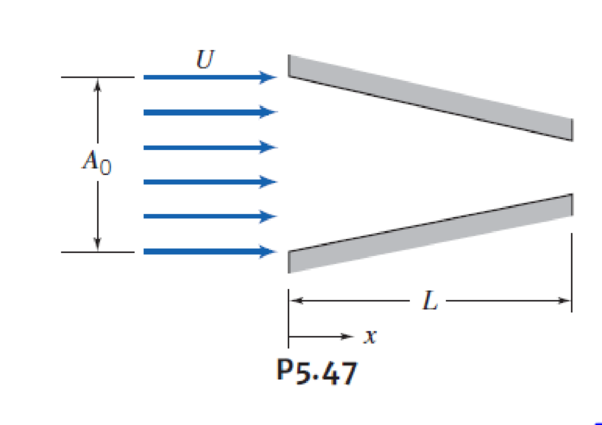
Consider the incompressible flow of a fluid through a nozzle as shown. The area of the nozzle is given by A = A0(l − bx) and the inlet velocity varies according to U = U0(0.5 + 0.5cos ωt) where A0 = 5 ft2, L = 20 ft, b = 0.02 ft-1, ω = 0.16 rad/s and U0 = 20ft/s. Find and plot the acceleration on the centerline, with time as a parameter.

Want to see the full answer?
Check out a sample textbook solution
Chapter 5 Solutions
Fox And Mcdonald's Introduction To Fluid Mechanics
Additional Engineering Textbook Solutions
Elementary Surveying: An Introduction To Geomatics (15th Edition)
Java: An Introduction to Problem Solving and Programming (8th Edition)
Thinking Like an Engineer: An Active Learning Approach (4th Edition)
Java How to Program, Early Objects (11th Edition) (Deitel: How to Program)
Starting Out With Visual Basic (8th Edition)
Starting Out with Programming Logic and Design (5th Edition) (What's New in Computer Science)
- Air at 30C and atmospheric pressure flows with a velocity of 6.5 m/s through a 7.5 cmdiameter pipe shown in Figure Q 1(a). The average wall roughness of the pipe is 0.002mmand the value of μ/ρ is 1.6x10-5 m2/s at 30C. Where μ is the coefficient of dynamic viscosityof air and ρ is the density of air. Determine the friction head loss across 30m length of thepipe.arrow_forwardAn incompressible fluid flows in the converging pipe.A=Ao*(1-b*x) is given for pipe area.Input speed is V=Vo*(0,5+0,5*cos*ω*t).Given as Ao=1,5 m2, L=13m, b=0,2/15 , ω =0,16rad/s. , Vo=3 m/sFind the acceleration in the center of pipe as a function of time (t).arrow_forwardWater steam is running through the nozzle. Inlet pressure is P1=25 bars; T1=300C; V1=90m/s; A1=0.2m2. The exit parameters are: P2=11bars; T2=210C. The mass flow rate is m=2 kg/s. Determine: a.Exit velocity V2=?; b.Inlet and outlet diameters D1 and D2. show all stepsarrow_forward
- Please help me with this fluid mechanics question! Thank you!! :) A 1967 Harley-Davidson Shovelhead motorcycle uses a ventruri-carburetor to mix air and fuel for combustion. The venturi reduces the pressure to draw fuel from a reservoir chamber and to mix with the airstream as shown in the figure. The energy loss of the metering line is given by hL= (K*V^2)/2where K = 6.0 and V is the fuel velocity in the metering line. Assume that the air is an ideal fluid (68°F). Calculate the mass flux of air and the mass flux of fuel. Hint: Assume the air intake velocity is negligible.arrow_forwardA brand of toothpaste is made using a mixture of white and red paste. During the manufacturing process, both pastes are pumped through a pipe, with the red paste lying in the center of the pipe, as shown in Figure Q2. The pipe has an internal radius, R2, and the segment of red paste has a radius R1. The flow is found to follow the Poiseuille equation, i.e. 1 dp u(r) = -- 4µdx (R²2-²) Where u is the viscosity of the paste and dp dx is the pressure gradient. The total flow of toothpaste through the pipe is Qtot, and the flowrate of the red paste is Qred. The toothpaste has a density of p = 1200 kg/m3, and a viscosity of 0.03 Pa.s. The pipe has a radius R2 = 5 cm and a length L = 2 m. a) Find an expression for the flowrate of the red toothpaste. You answer should be in terms of µ, R1, R2, dp dx) b) The flow in the pipe becomes turbulent when the Reynolds number reaches 2000 (where Re is calculated using the mean velocity across the pipe). What is the maximum pressure drop along the pipe…arrow_forwardThe velocity profile of a liquid flows through the z direction of the vertical tube (figure right) with the radius ro is given as; r 1 dp Vz = (r² – r3) 2µ dz Specify the maximum velocity and derive an expression for the average velocity.arrow_forward
- Continuity equation: Calculate the inside diameter of the pipes at the inlet and outleta hydraulic pump whose volume flow is 40 l/min, knowing that the oil enters the pump at a speed of 1.2 m/sec andexits at a maximum speed of 3.5 m/sec. Answer: D1 = 26.6 mm and D2 = 15.6 mmarrow_forwardWater steam is running through the nozzle. Inlet pressure is P1=25 bars; T1=300C; V1=90m/s; A1=0.2m2. The exit parameters are: P2=11bars; T2=210C. The mass flow rate is m=2 kg/s. Determine: a.Exit velocity V2=?; b.Inlet and outlet diameters D1 and D2.arrow_forwardPlease Answer Both!!!arrow_forward
- What must the gauge pressure p be at A if the volume flow rate out of the pipe at point B is 0.0800 m^3/s?arrow_forwardplease refer to image tqarrow_forwardWater flows in a 170 mm diameter pipeline (A) divides into two smaller pipelines, one being 100 mm in diameter (D) and the other being 80 mm in diameter (B). If the velocity in the 80 mm pipe (B) is 0.6m/s and that in the 100 mm pipe (D) is 0.9m/s, calculate the velocity in m/s and the mass flow rate in kg/s in the 170 mm pipe (A.arrow_forward
 Elements Of ElectromagneticsMechanical EngineeringISBN:9780190698614Author:Sadiku, Matthew N. O.Publisher:Oxford University Press
Elements Of ElectromagneticsMechanical EngineeringISBN:9780190698614Author:Sadiku, Matthew N. O.Publisher:Oxford University Press Mechanics of Materials (10th Edition)Mechanical EngineeringISBN:9780134319650Author:Russell C. HibbelerPublisher:PEARSON
Mechanics of Materials (10th Edition)Mechanical EngineeringISBN:9780134319650Author:Russell C. HibbelerPublisher:PEARSON Thermodynamics: An Engineering ApproachMechanical EngineeringISBN:9781259822674Author:Yunus A. Cengel Dr., Michael A. BolesPublisher:McGraw-Hill Education
Thermodynamics: An Engineering ApproachMechanical EngineeringISBN:9781259822674Author:Yunus A. Cengel Dr., Michael A. BolesPublisher:McGraw-Hill Education Control Systems EngineeringMechanical EngineeringISBN:9781118170519Author:Norman S. NisePublisher:WILEY
Control Systems EngineeringMechanical EngineeringISBN:9781118170519Author:Norman S. NisePublisher:WILEY Mechanics of Materials (MindTap Course List)Mechanical EngineeringISBN:9781337093347Author:Barry J. Goodno, James M. GerePublisher:Cengage Learning
Mechanics of Materials (MindTap Course List)Mechanical EngineeringISBN:9781337093347Author:Barry J. Goodno, James M. GerePublisher:Cengage Learning Engineering Mechanics: StaticsMechanical EngineeringISBN:9781118807330Author:James L. Meriam, L. G. Kraige, J. N. BoltonPublisher:WILEY
Engineering Mechanics: StaticsMechanical EngineeringISBN:9781118807330Author:James L. Meriam, L. G. Kraige, J. N. BoltonPublisher:WILEY





